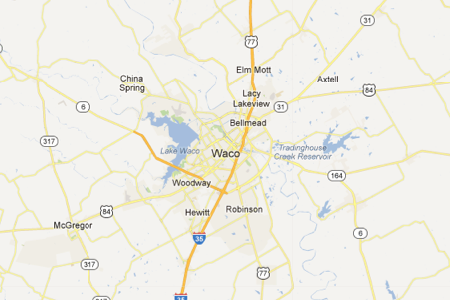Waco: The City Where the Waco Siege Didn't Actually Happen

Today, April 19, 2013, is the twentieth anniversary of the bloody end to the "Waco" Siege at the Branch Davidian's Mount Carmel compound -- a forlorn place that is, in fact, 13.8 miles east of the city of Waco.
I do not know who was the first person to assign the name of "Waco" to the terrible events that took place 20 years ago. What I do know is that he or she did a great disservice to Waco, often pronounced "Wacko," as I have heard repeatedly whenever I tell someone that I was born and raised in the city.
Let me be quick to own that Waco has had its share of problems, one of them a so-called act of God, a 1953 tornado that killed more than 100 people and blew away much of downtown. As a young boy, I watched from the picture window of my father's real estate office about one and a half miles from the eye of the storm. The day turned completely dark, almost black, and downtown was never the same.
Then the feds closed a big Air Force base and a tactical fighter wing, and the people and the real estate market went, if not altogether south, then off to Austin, Houston, or Dallas.
And speaking of the South, Waco was the farthest extension of the Old South, sending soldiers off to the lost Confederate cause, including several generals. As an approximate end point for the reach of slavery, the city has had its share of tragic relapses to the harshness of Reconstruction, but now struggles more conventionally with the issue of race.
Waco is also associated with the Baptist denomination, mainly because Baylor University is located in the city. Baylor can be the butt of jokes, a few of them earned, but the university and its religion department are actually a significant moderating influence, in Texas and worldwide. Baylor also has excellent academic programs in business and law, and recently, engineering.
Ann Richards was a Baylor grad, along with four other Texas governors, three U.S. Senators, and about a dozen congressmen.
I did not attend Baylor (one of my daughters did), and I do not live in Waco. Yet this business of referring to the city as the site of the siege and its fiery climax has bothered me for years, particularly since President George W. Bush decided to buy a ranch near Crawford, Texas.
Now Crawford, Texas, is a town of about 800 located exactly 24.4 miles west of the city of Waco. How many news datelines have begun something like this, "Crawford -- We are at President Bush's ranch near Crawford, Texas, where he just announced..."?
As I see it, the net geographical difference between being identified with a president versus becoming the name for a national tragedy is about 10.6 miles -- the difference between the distances of Mount Carmel and Crawford from Waco. For otherwise, wouldn't we have seen datelines saying, "Waco -- President Bush announced from his ranch near here today that..."?
The closest town to Mount Carmel is Elk, a tiny hamlet of about 150 souls. Also nearby is the town of Hallsburg with a population of about 800. Depending on where one might be standing in these towns, the distance to Mount Carmel would be around 3 or 4 miles, or even less.
Now this is not an argument that the so-called "Waco Siege" now be referred to as the "Elk Siege" or the "Hallsburg Siege." But there are, in truth, striking examples of how tragedies are not named for the towns near which (or even in) the cities where they occurred.
Thus we have the "Columbine" massacre, even though the high school has an address in Littleton, Colorado. There are the "Aurora" theater shootings, referring to the Denver suburb less than nine miles out of town.
Columbine, in naming an awful event for the school in which it occurred, both narrows the location to an actual structure and reminds us that it was tragedy of the most terrible kind, one in which children were killed. Yet naming an event for its exact location would seem to suggest a more logical name for the "Waco" siege: Mount Carmel. For that is where the Davidian compound was located. Not in Waco, Texas.
Instead of a Frontline documentary on "Waco -- the Inside Story," or the award-winning "Waco: the Rules of Engagement," we would have "Mount Carmel: the Tragic Siege." But then we could have a dispute over naming a tragedy after the mountain where the prophet Elijah challenged each false, contending deity to make a sacrifice and then cause it to blaze; the one who succeeded could claim to be the true god. The deities failed, but the sacrificial altar erupted in flames, destroying the altar, sacrifices, wood and stone. The Bible says it was a real act of God.
Endnote: On April 17, a fertilizer plant exploded in West, Texas, about 18 miles north of Waco.
